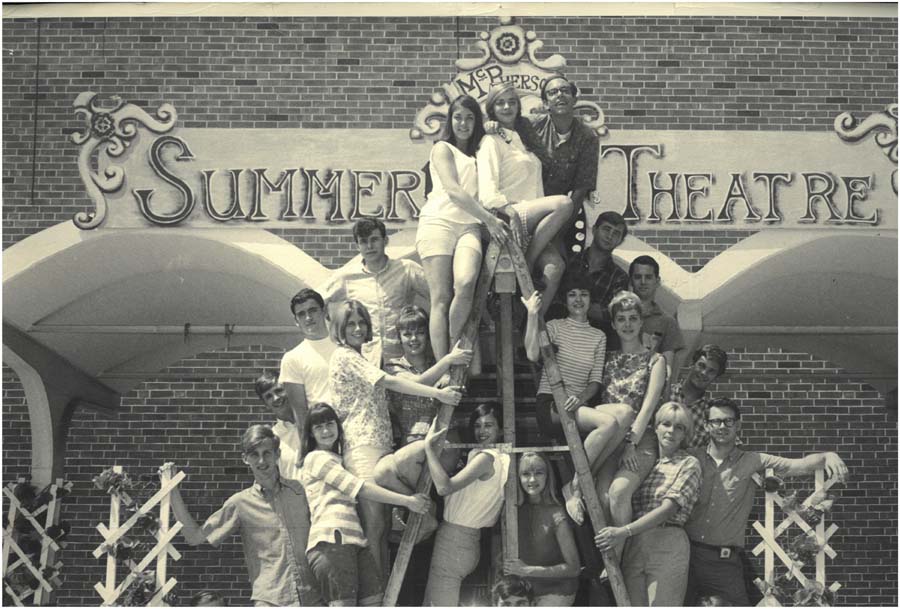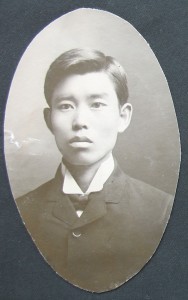This post traces the origins of and changes to the Bachelor of Arts and Bachelor of Fine Arts degrees for IWU’s theatre program as found through examining the Catalogue of Courses held in the University’s Archives.
Starting in 1945-46 academic year, students could take a course in dramatics from among offerings in the Humanities division in the College of Liberal Arts but dramatic productions had their origin in the student organization known as the Masquers starting in 1916. IWU’s Speech program is associated with this area of study beginning in the 1920s.

Richard Jenkins, Class of 1969, is in a white t-shirt, third man up on the left side of this photo. Contact archives@iwu.edu if you can identify any of the others. (click to enlarge)
1947-48 BA and BFA awarded in Dramatics: This is the first time the School of Dramatics is listed as an independent unit within the College of Fine Arts. “The courses in Dramatics are offered 1) as part of a liberal education, 2) as training for teachers and directors in schools, and 3) as preparation for work in the theatre, either community or professional.” (see catalog p. 153). The catalog also notes that a BA in Dramatics through the Division of Humanities is available on completion of 16 semester hours (of 126 total) in Dramatics. BFAs require 60-100 semester hours in Dramatics and “allied fields.” Professor of Dramatics Lawrence E. Tucker, M.A., is the School’s first Director and it was his first year on campus.
1951-52 BA and BFAs awarded in Drama and in Drama and Speech — the year that the unit becomes known as School of Dramatics and Speech. Tucker is still the director (see catalog p. 137). Candidates for BFAs “must present a minimum of 124 semester hours.” BAs are earned through the Division of Humanities after completion of 24 semester hours.
1964-65 BA and BFAs awarded in Drama — the year the unit becomes the School of Drama. The courses in Drama are offered 1) as part of a liberal education, 2) as training for teachers and directors in schools, 3) as preparation for work in television or the theatre, either community or professional, and 4) as preliminary work for graduate study” (see catalog p. 119). Tucker is still the director but is listed with a Ph.D. at this time. Candidates for BFAs “must present a minimum of 130 semester hours.” BAs are earned through the Division of Humanities after completion of 24 semester hours (of 124 total).
1978-79 BA and BFAs awarded in Drama and in Music-Theatre — the unit is still The School of Drama. “The Music-Theatre Degree Program at Illinois Wesleyan University has as its goal the training of young people for careers in musical theatre. It is a complete and intensive course of study leading to a degree, Bachelor of Fine Arts in Music-Theatre” (catalog p. 125). Associate Professor of Drama Carole A. Brandt, Ph.D., became the director in 1977. BAs are awarded in the College of Liberal Arts after completion of 34 course units. BFAs in drama require 34 units; BFAs in Music-Theatre require 36 units.
1993-94 Music Theatre, Theatre Arts — the year it becomes The School of Theatre Arts. Professor of Theatre Arts Jared Brown, Ph.D. is listed as the director with a start date of 1989. BAs are awarded in the College of Liberal Arts after completion of 35 course units. BFAs in theatre arts require 35 units; BFAs in Music-Theatre require 36 units.
2003-04 Acting, Music Theatre, Theatre Design and Technology — still The School of Theatre Arts. Professor of Theatre Arts Nancy B. Loitz, M.F.A., is listed as the director with a start date of 1999. Of 32 total course units required for graduation, BAs in Theatre Arts need 12; and BFAs in Acting need 20.5 units, BFAs in Music Theatre need 22.25 units, and BFAs in Theatre Design and Technology need 19 units.

